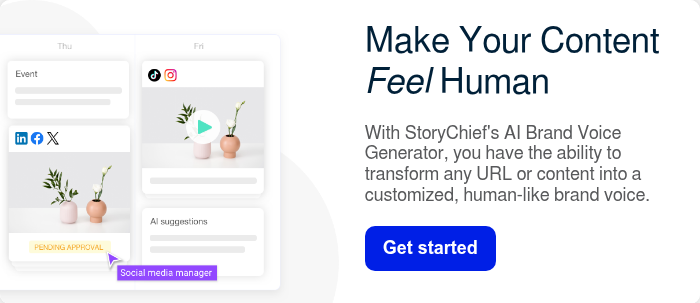Why brand voice management matters for AI-driven content
Why do some pieces of content grab your attention quickly and others vanish like you never saw them?
In an AI-driven world, you see endless content daily. AI can produce grammatically correct and structured content, but it's forgettable. The major difference lies in brand voice. It’s the unique personality, tone, and style that make content human, relatable, and impossible to scroll past.
In this article, we will discuss what brand voice management is, how it impacts engagement, how AI changes the game, how to define your brand voice, and common mistakes to avoid.
What Do You Mean by “Brand Voice Management”?

Brand voice is the personality and tone behind your content. It's the unique way your brand communicates with your ideal customers.
It consists of:
- Tone: The emotional connection with your audience in your messages (e.g., friendly, authoritative, humorous).
- Language: The choice of words and phrases that reflect your brand's identity.
- Style: The structure and flow of your content, including sentence length and complexity, are all key elements of effective business writing that help your message sound clear and consistent.
Consider Innocent Drinks, a smoothie brand. Their voice is playful and friendly, their language is simple, conversational, and often humorous, and their style uses short, approachable sentences with a casual tone that feels like chatting with a friend.

By defining a clear brand voice, companies ensure that every message they send showcases their identity and builds trust, and boosts audience engagement. In short, brand voice is a way to make your organization stand out from the crowd.
Related article: 12 Tone of Voice Examples (+ Free Brand Voice Tool)
Why Brand Voice Management Impacts Engagement
The impact of brand voice on engagement is huge. Let us understand why brand voice impacts engagement.
Builds trust
A consistent brand voice strengthens familiarity with your brand. When your audience recognizes your tone and style, they feel more comfortable engaging with your content. Here’s something that supports this point: According to Sprout Social, social media posts with a consistent brand voice get 23% more engagement. To operationalize this, evaluate AI tools that standardize tone across writers and channels.
Sparks recognition
In a competitive market where your competitors are constantly improving and trying to capture your target audience, you need something different. Having something unique in your brand is crucial. A distinctive brand voice makes your content instantly recognizable.
Creates emotional connection
People connect with people and not with static brands. A humanized brand voice can generate emotions, making your audience more likely to engage, share your content, and convert. Therefore, having a brand voice that speaks the language of your ideal customer creates a huge impact.
How AI Changes the Game (and Why Voice Matters Even More Now)
Artificial intelligence has revolutionized content creation. It has given the superpower to brands to produce high volumes of materials quickly and efficiently. However, without a distinct and consistent brand voice, AI-generated content can feel generic and fail to engage audiences effectively. Phrases like “supercharge your growth,” “leverage innovative solutions,” or “in the dynamic world of AI” have become cliches, making AI content blend in rather than stand out.
Brands that fail to include personality produce content that looks polished but doesn’t connect. Consider an AI-generated subject line for an email: “Maximize your ROI by leveraging cutting-edge tools.” Technically, it's correct, but it's forgettable.
Consider Netflix’s “Cinebot” AI system. It analyzes hours of video content to generate personalized trailers. The system evaluates visual appeal, emotional impact, and viewing history to create thousands of unique content pieces.
At first, this might seem technical, but the key is how Netflix ensures its content resonates with the target audience. Despite AI producing thousands of variations, the language, tone, and style are carefully guided by the brand’s playful, engaging, and often witty voice.
Similarly, AI voice technology is transforming how brands connect with audiences beyond text. Instead of only reading a blog post, imagine your brand voice being delivered in a natural-sounding AI narration across podcasts, YouTube explainers, or customer support bots. The words may be generated by AI, but when paired with the right voice tone, they feel alive, human, and relatable.
The lesson to learn here is: AI can produce content as much as you want, but your voice is what makes it memorable, engaging, and human.
Related article: How To Make AI Sound More Human: Steal My Workflow for Authentic Content
Free tool: Analyze your target audience, brand voice, content pillars and competitors. Try it now.
How to Define Your Brand Voice

Marketers need clear brand voice management guidelines to keep messaging aligned across every channel. Defining your brand voice is not complicated. Follow these steps to create a voice that resonates with your audience and stays consistent across all platforms:
Step 1: Identify your core values
Decide what your brand represents. Is your brand professional, playful, bold, or supportive? These values shape the tone, language, and style of your brand. For example, Mailchimp is playful and witty, and IBM is professional and authoritative.
Step 2: Understand your audience
Analyze your target audience and find their words and tone. B2B audiences prefer concise, expert language, whereas lifestyle brands’ audiences find humor or casual messaging more convincing.
Step 3: Audit your existing content
Look at your current blogs, emails, and social posts that you have published. Which pieces feel “on brand” and figure out which don’t. This helps identify patterns and gaps.
Step 4: Create simple guidelines
Document your preferred words, phrases, punctuation, sentence structures, and style do’s and don’ts to ensure consistency of your brand voice. Also, note what to avoid in your content, like overused AI jargon such as “supercharge” or “leverage.”
Step 5: Use tools to refine your voice
Use free tools like StoryChief’s brand voice generator that help you design your tone from existing content. Adjust sliders for seriousness, playfulness, or enthusiasm, and save multiple voices for different projects or channels.
How to Keep Voice Consistent Across Channels (and Teams)
Managing your brand voice is important, but keeping it consistent across various social media content forms, websites, blogs, and emails is challenging. Here’s how to do it:
Step 1: Centralize your workflow
Use a single content planning tool or workflow that is accessible to everyone in your team. This ensures all writers, marketers, and freelancers work based on the same guidelines.
Step 2: Build templates for every channel
Emails, blogs, LinkedIn posts, and TikTok captions all have different formats. What’s important is that your tone should stay the same. Create templates that define length, structure, and example language for each platform.
Step 3: Review and evolve regularly
Your brand isn’t static. As your audience changes, the preferences change. Therefore, revisit your voice guidelines. Refresh phrases, add new do’s and don’ts, and remove the outdated styles that don’t work.
Step 4: Use tools to stay consistent
AI tools like StoryChief’s free brand voice generator can help teams replicate tone across platforms. By training the tool on your past content, you can quickly generate new pieces that sound “on brand,” regardless of who writes them.
Consistency builds trust. When your audience recognizes your voice instantly, you win the game of brand recall and loyalty.
Common Mistakes to Avoid
Many brands may make mistakes even if they have clear guidelines. Let us look at the common mistakes to avoid:
Mistake 1: Sounding robotic with AI tools
AI can generate a lot of content, but if you publish it as it is, then it doesn’t resonate with your audience the way you expect it to. Overused phrases like “supercharge your growth” or “leverage innovation” instantly signal that it's a generic AI-generated copy. You need to delete robotic, redundant phrases so your real personality shines.
Mistake 2: Changing tone too often across channels
Every platform has its own uniqueness. Therefore, you cannot have the same format for LinkedIn and emails, but you can communicate with your audience in the same tone.
If your tone shifts too much between platforms, the audience loses trust.
Mistake 3: Copying competitors instead of creating your own style
It’s tempting to mimic brands you admire, but that doesn’t give you authenticity. Your voice should reflect your own values, not someone else’s. A copied style may win attention in the initial stages, but it won’t give loyalty.
Avoiding these mistakes ensures your brand voice remains distinct, trustworthy, and memorable.
The Payoff: What Strong Brand Voice Looks Like in Action

When you invest in building and managing a strong brand voice, you can expect the following results:
- Higher engagement: Content that is crafted with a clear voice stands out. Instead of getting lost in this competitive world of AI-generated sameness, they grab attention. As a result, it leads to more clicks, shares, and comments.
- Stronger loyalty: A brand that is instantly recognized based on the tone builds trust. After a certain interval of time, audiences begin to know your “sound” the same way they’d recognize a friend’s text. That familiarity leads to repeated readers, subscribers, and customers.
- AI content that feels human: AI is a powerful tool that generates content on a single click, but voice makes the content feel like you. With the right tone in AI-assisted blogs, emails, or social posts, they feel personal, relatable, and memorable.
Brand Voice Examples: Strong B2B Brands Doing It Right
Next, let us look at some of the prominent B2B brands and understand their brand voice.
1. Microsoft
Voice: Simple, human, helpful
Language: Microsoft’s style guide emphasizes clarity. They prefer everyday words over technical jargon, use contractions, and aim for brevity.
Style: Warm, relaxed, and precise. Sentences are short and scannable. They focus on the key takeaway upfront. The tone shifts depending on context, but the voice remains consistent.
2. Salesforce
Voice: Inspirational, trustworthy, values-driven
Language: Their communications reflect their guiding values. They use words like “trust,” “customer success,” “innovation,” and “together.” The tone is positive and uplifting.
Style: Educational. In their content, Trailhead, how-to guides, and marketing, they aim to teach while being human. They include “voice & tone” guidelines and keep examples of “good vs bad” copy to reinforce what works.
3. Google
Voice: Conversational, friendly, authoritative, but approachable.
Language: They avoid overly formal language or slang. They aim for natural speech patterns without being sloppy. Explanations are clear and easy to understand. Terms are defined; they acknowledge complexity but simplify it.
Style: More informal in tone than traditional formal documentation, yet still professional. They aim to be “a knowledgeable friend.” Visual hierarchy and formatting (bullet points, headings) help with scannability. Emphasis on clarity, correctness, and telling people what to do (actionable).
4. Adobe
Voice: Genuine, progressive, inspiring
Language: They use authentic, positive, forward-looking words (e.g., “inspire,” “progressive”). They prefer accessible language, avoid jargon unless necessary, and want content to feel like it’s pushing ideas forward, not just describing what is already done.
Style: Their editorial guidelines are precise: tone of voice categories, values, plus rules about style (e.g., sentence length, syntax, use of specific punctuation, avoiding clichés) and editorial restrictions. They want content to be coherent across formats, ads, marketing, and documentation.
Brand Voice Management is Your Edge
In an era where people are presented with a lot of content daily, what makes them listen to you is your voice. A brand voice builds trust, sparks recognition, and makes AI-assisted content unique.
If you want your brand voice on engagement to be consistent using AI, try StoryChief. It can streamline your content operations.








